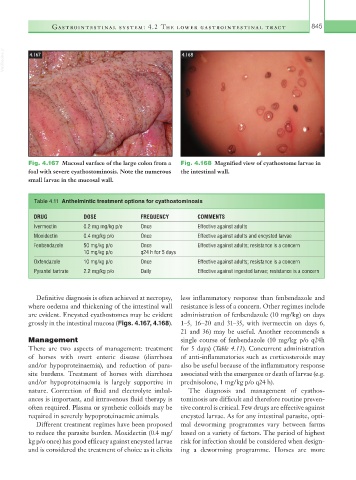Page 870 - Equine Clinical Medicine, Surgery and Reproduction, 2nd Edition
P. 870
Gastrointestinal system: 4.2 The lower gastrointestinal tr act 845
VetBooks.ir 4.167 4.168
Fig. 4.167 Mucosal surface of the large colon from a Fig. 4.168 Magnified view of cyathostome larvae in
foal with severe cyathostominosis. Note the numerous the intestinal wall.
small larvae in the mucosal wall.
Table 4.11 Anthelmintic treatment options for cyathostominosis
DRUG DOSE FREQUENCY COMMENTS
Ivermectin 0.2 mg mg/kg p/o Once Effective against adults
Moxidectin 0.4 mg/kg p/o Once Effective against adults and encysted larvae
Fenbendazole 50 mg/kg p/o Once Effective against adults; resistance is a concern
10 mg/kg p/o q24 h for 5 days
Oxfendazole 10 mg/kg p/o Once Effective against adults; resistance is a concern
Pyrantel tartrate 2.2 mg/kg p/o Daily Effective against ingested larvae; resistance is a concern
Definitive diagnosis is often achieved at necropsy, less inflammatory response than fenbendazole and
where oedema and thickening of the intestinal wall resistance is less of a concern. Other regimes include
are evident. Encysted cyathostomes may be evident administration of fenbendazole (10 mg/kg) on days
grossly in the intestinal mucosa (Figs. 4.167, 4.168). 1–5, 16–20 and 31–35, with ivermectin on days 6,
21 and 36) may be useful. Another recommends a
Management single course of fenbendazole (10 mg/kg p/o q24h
There are two aspects of management: treatment for 5 days) (Table 4.11). Concurrent administration
of horses with overt enteric disease (diarrhoea of anti-inflammatories such as corticosteroids may
and/or hypoproteinaemia), and reduction of para- also be useful because of the inflammatory response
site burdens. Treatment of horses with diarrhoea associated with the emergence or death of larvae (e.g.
and/or hypoproteinaemia is largely supportive in prednisolone, 1 mg/kg p/o q24 h).
nature. Correction of fluid and electrolyte imbal- The diagnosis and management of cyathos-
ances is important, and intravenous fluid therapy is tominosis are difficult and therefore routine preven-
often required. Plasma or synthetic colloids may be tive control is critical. Few drugs are effective against
required in severely hypoproteinaemic animals. encysted larvae. As for any intestinal parasite, opti-
Different treatment regimes have been proposed mal deworming programmes vary between farms
to reduce the parasite burden. Moxidectin (0.4 mg/ based on a variety of factors. The period of highest
kg p/o once) has good efficacy against encysted larvae risk for infection should be considered when design-
and is considered the treatment of choice as it elicits ing a deworming programme. Horses are more

